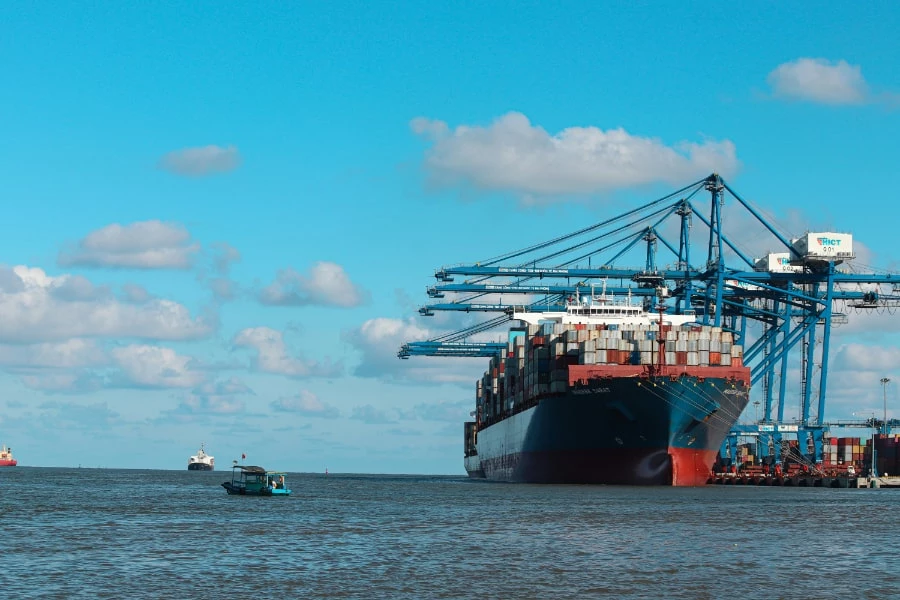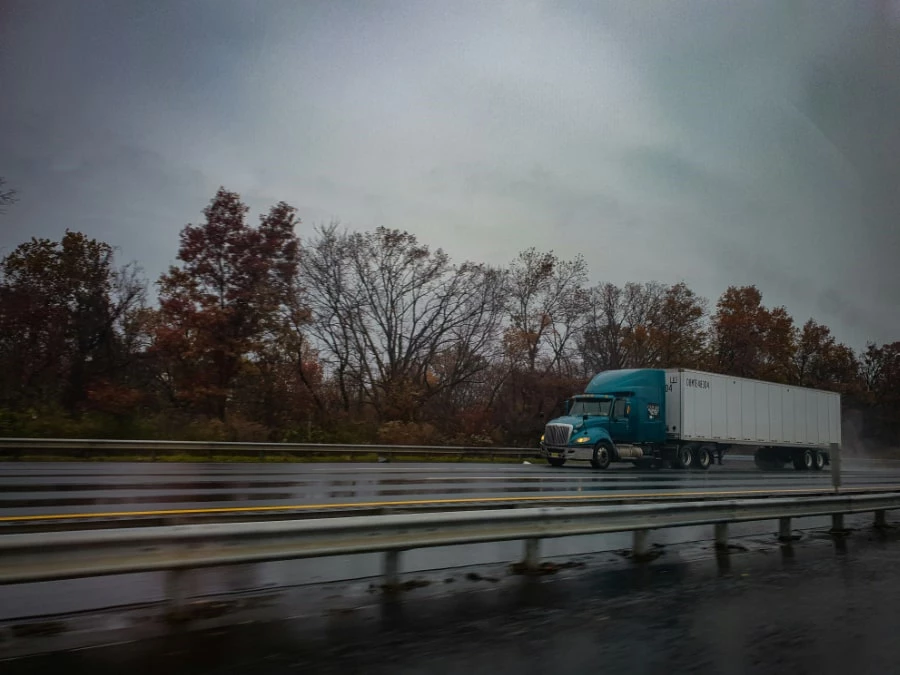How are international shipping costs determined? Learn what factors contribute to the final price and how these costs are calculated. You may already be aware that the total cost of a product consists of three main components. These are the product price, paid to your supplier; transport costs, paid to a freight forwarder; and customs costs. Sometimes, VAT is also added to your goods, which you pay to local authorities. This article will focus on the expenses that influence your shipping costs.
The 7 steps in calculating shipping costs
Understanding the seven steps of the international shipping process is crucial for accurately interpreting future quotes and invoices. These steps lay the foundation for all shipping costs and offer deeper insights into what you are paying for and when these costs are incurred.
Regardless of the shipping destination or method (sea, air, road, or rail freight), costs are always based on the following seven stages of the transport process:
1. Export transport (collection)
2. Export customs clearance
3. Goods handling in the country of origin
4. Freight
5. Import customs clearance
6. Goods handling at destination
7. Import transport (delivery)
Not all parts will be included in your shipping costs. For shipping within Europe, the costs usually depend on the trade terms you and your supplier have agreed upon. For shipping outside Europe, the price typically depends on the volume of goods you have.
Overseas transport
In the case of international transport, you often have two shipping options to choose from: sea freight and air freight. The inclusion of the seven steps in your shipping costs is determined by the specific delivery terms agreed upon between you and your supplier. These terms should be clearly stated in your invoice, as they outline when the responsibility for the goods and associated transport costs transfer from the supplier to you.
How are transportation costs determined for international shipments?
Transportation costs for international shipments, whether by sea or air, are significantly influenced by the nature of the goods being transported. Each mode of transport has its limitations: ships have finite space, and aircraft must adhere to strict weight restrictions. As a result, the cost often varies more significantly with the weight of the shipment rather than its volume. Below, we outline how these prices are typically calculated.
Read more: Which transport solution should you choose?
Different types of shipping and what it costs
Sea freight shipping cost
For sea freight, there are two different shipping options: LCL (Less Than Container Load) and FCL (Full Container Load). The cost of boat transportation varies depending on which option you pick.
LCL (Less Than Container Load) is a general cargo transport that is relevant for smaller deliveries where several importers share a shipping container. LCL is best suited for shipments that are less than 15 m³. FCL (Full Container Load) on the other hand is a better choice when you ship more than 15 m³ as you have the option to fill a whole container yourself.

Freight companies calculate prices based on the volume (cubic meters), which reflects the space occupied by the goods. Generally, the greater the volume, the higher the price. Additionally, the cost is influenced by the location of the pick-up. For example, if your goods are to be picked up several hundred kilometers inland in China, the shipping costs for collection will be significantly higher than if your supplier is located in a coastal city like Shanghai, which has its own port.
FCL (Full Container Load)
The price of FCL varies considerably, which depends on the basic principle of supply and demand. If a certain trade route has half-full or empty container ships, the price is reduced, and vice versa. In addition, other factors such as exchange rates, oil prices, and traffic conditions impact the price. Additional charges may apply, such as war risk charges or seasonal variations.
LCL (Less Than Container Load)
LCL prices show significantly less variation, as the shipping cost itself is only a small part of the total cost of LCL shipments. The larger costs are instead tied up in collection, export and import handling, and delivery.
Read more about our sea freight here.
Air freight shipping cost
How much does air freight cost? The key distinction between sea freight and air freight lies in the timing. If speed is crucial, and you need to transport your goods quickly, air freight is the preferred method. Depending on the service level and the origin, transit times for air shipments typically range from 3 to 12 days.
Air freight can be categorized into two main types: standard freight and courier services. Below, we will explore the pricing for air freight based on these categories:
Standard air freight
The cost of standard air freight is primarily determined by the volumetric weight, also known as dimensional weight or bulk weight. This calculation is based on a DIM (Dimensional Weight) factor set by the airline, which reflects the cargo capacity of the aircraft.
To calculate the volumetric weight of a shipment, you divide the volume in cubic centimeters by 6,000, which is the standard DIM factor per kilogram for regular air freight, translating to approximately 166.67 kilograms per cubic meter. For instance, if you have a cubic meter of goods weighing 100 kg, the chargeable weight will be 167 kg, due to the DIM weight. However, if the actual weight exceeds the volumetric weight, such as 1 cubic meter weighing 500 kg, you will be charged based on the actual weight of 500 kg.
Pricing is also influenced by the specific route, which is determined by the airline based on supply and demand, similar to sea freight. The capability of the freight forwarder to negotiate large purchases can also impact the price. Additionally, factors such as currency exchange rates, fuel surcharges, and transit times are frequently reflected in air freight rates, indicating that prices may increase with shorter transit times.
Sea freight vs. air freight
A useful guideline is that if your shipment is less than 0.5 cubic meters and weighs under 100 kg, air freight might be competitively priced compared to sea freight. This is because sea freight has a minimum chargeable volume of 1 cubic meter, regardless of the actual smaller volume. For shipments exceeding 0.5 cubic meters and 100 kg, sea freight generally becomes the more cost-effective option. It’s important to consider that transit times can be significantly longer with sea freight—up to 43 days from locations like China, depending on the specific shipping route.
Road freight shipping cost
Road transport is a common method for both domestic and short-haul international shipments, typically following fixed routes and schedules. Trucks often have daily or weekly departures across Europe, allowing for pick-up as soon as the day after booking.
Road transport can be categorized into several types: LTL (Less than Truckload), consignments, and FTL (Full Truckload). Note that the exact definitions of these categories may vary between different forwarders.
LTL

LTL (Less than Truckload) typically involves shipping 1–2 pallets, where you purchase specific pallet spaces in a truck and share the shipping costs with other importers. The goods are initially picked up by a smaller truck and transported to a warehouse, where they are transferred onto a larger truck for export. Upon arriving in the destination country, the goods are moved to a local warehouse and eventually delivered to the final destination by a smaller truck.
Party broadcasts
Consignments generally involve transporting three or more pallets and are often handled directly by larger export trucks. These trucks may stop at a warehouse to load LTL shipments; however, handling costs at warehouses are minimized because the goods are not reloaded. Consignments are particularly advantageous for bulk shipments or items of unusual size that are difficult to handle, as they streamline the transport process.
FTL
FTL is full load, where you as a customer buy the truck's full capacity – typically 33 pallet spaces or around 90 m³ for a standard curtain trailer. When you buy a full load, you avoid handling and transshipment costs because the export truck runs directly from the supplier to you. This can result in a slightly shorter transport time. As a rule, it is more advantageous to buy a consignment if you are sending fewer goods than the equivalent of half a truckload.
Most freight forwarders and carriers have fixed rates for LTL shipments based on volume, weight, and distance. Each country is divided into zones, and the price is based on which zones the carrier starts and ends in. This way, the freight forwarder can easily determine the price based on the zones. In addition, there are fuel surcharges and any additional charges if your goods require special handling.
Rail freight shipping cost
How much does rail freight cost? Rail transport offers several advantages: it's more cost-effective than air freight, faster than sea freight, and more environmentally friendly than road transport. Like road and sea freight, the costs of rail freight depend on the destination and demand. Typically, our rail freight solutions use multimodal transport, which includes inland transport following the initial delivery of ocean freight to a dock. This integrated approach ensures efficient and cost-effective transportation across multiple channels.
To accurately price rail shipments, it is crucial to know the size of your cargo and the total volume you plan to send. Evaluating the overall freight costs against the cost per cubic meter is essential to determine the most economical shipping method.
Contact us at Bertling for the latest prices
As you understand by now, the price can vary quite a bit from one shipment to another. We are always careful to offer you the most affordable option, and always inform you of the costs of your shipping. Contact us to get the latest prices!
